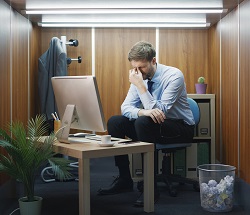You saved the commute. You gained back hours. You even have time for morning walks now. So why does working from your home office sometimes leave you more exhausted than any corporate cubicle ever did?
TL;DR
- Home offices often create micro-tensions from poor ergonomics.
- These small physical stresses drain energy by mid-afternoon.
- You can reduce the crash without buying expensive furniture.
What Is the Hidden Cost of Remote Work?
You gained freedom and flexibility, but now feel more tired than ever. The problem? Micro-tensions caused by makeshift home workspaces.
“Remote work saves you time but silently costs you energy if your setup is off.”
Why This Matters in 2025 and Beyond
As remote work becomes standard, more people are working from suboptimal setups. Dining chairs, low tables, and laptop screens aren’t built for all-day use.
- Your neck angles downward all day.
- Wrists bend slightly, creating tension.
- Lighting glare causes squinting and eye strain.
Each issue may seem small—but combined, they wear you down.
How to Stay Energized in Your Home Office: 3 Simple Fixes
1. Identify Your Micro-Tensions
Notice small strains: shoulder tension, wrist discomfort, or squinting. These are energy leaks.
2. Modify with What You Have
Raise your laptop with books. Add a cushion for hip alignment. Adjust lighting to reduce glare.
3. Reset Physically Every 60–90 Minutes
Use a “60 Second Desk Reset” to counteract micro-strain and keep your energy online.
When Your Home Office Becomes an Energy Drain

It’s the paradox no one warned you about—trading fluorescent lights and office politics for the comfort of home, only to find yourself mysteriously drained by 4 PM.
The culprit isn’t your productivity or your motivation. It’s likely something far more subtle—the improvised workspace you’ve created in the corner of your bedroom, living room, or kitchen.
Most home offices weren’t designed; they evolved. The dining chair that became your office chair. The table that sits just slightly too low. The laptop screen that forces your neck to angle downward all day. The window that casts glare across your screen every afternoon, making you squint without realizing it.
These aren’t dramatic problems. They’re tiny incompatibilities between your body and your workspace that create what ergonomists call “micro-tensions”—small, persistent physical stresses that individually seem insignificant but collectively drain your energy reserves hour by hour.
Your shoulders raise slightly to compensate for a table that’s too low. Your wrists bend at subtle angles because your keyboard isn’t positioned ideally. Your hip flexors tighten from sitting on a cushion that’s a bit too soft. None of these adjustments hurt, at least not immediately, but they all require energy to maintain.
By mid-afternoon, your body has been quietly working overtime just to stay in position. No wonder your concentration wavers, your patience thins, and tasks that should be simple suddenly feel monumentally difficult.
The home office advantage can quickly become a liability when your space silently sabotages your stamina. And unlike a corporate environment where someone else might eventually address widespread discomfort, at home, the solution rests entirely with you.
But here’s the encouraging truth: You don’t need to invest thousands in ergonomic furniture or completely renovate your space. Sometimes the most effective intervention isn’t changing your environment, it’s changing how your body responds to it.
Final Thoughts
You don’t need more motivation, you need less resistance. When your space supports your posture, you stop burning energy just to sit.
“The best upgrade to your productivity might be how your body relates to your workspace.”
Start by noticing what your body has been compensating for. Then download the Desk Reset PDF and give yourself the midday reboot your focus has been missing.
